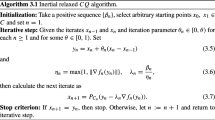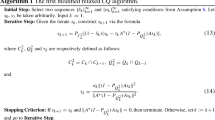Abstract
In this paper we are concerned with the Split Feasibility Problem (SFP) in which there are given two Hilbert spaces \(H_1\) and \(H_2\), nonempty, closed and convex sets \(C\subseteq H_1\) and \(Q\subseteq H_2\), and a bounded and linear operator \(A:H_1 \rightarrow H_2\). The SFP is then to find a point \(x^*\in C\) such that its image under A belongs to Q, meaning that \(Ax^*\in Q\). This reformulation was employed successfully for solving many inverse problems: for example, in intensity-modulated radiation therapy treatment planning. One of the typical classes of methods that have been used to solve the SFP is the class of projection method. This note focuses on the modified relaxation CQ algorithm with the Armijo-line search rule for solving the SFP. Under common and standard assumptions, we show that the proposed method weakly converges to a solution of the SFP. Numerical examples illustrating our method’s efficiency are presented for solving the LASSO problem in which the goal is to recover a sparse signal from a limited number of observations.



Similar content being viewed by others
References
Censor, Y., Elfving, T.: A multiprojection algorithm using Bregman projections in a product space. Numer. Algorithms 8, 221–239 (1994)
Censor, Y., Bortfeld, T., Martin, B., Trofimov, A.: A unified approach for inversion problems in intensity-modulated radiation therapy. Phys. Med. Biol. 51, 2353–2365 (2006)
Censor, Y., Gibali, A., Reich, S.: Algorithms for the split variational inequality problem. Numer. Algorithms 59, 301–323 (2012)
Byrne, C., Censor, Y., Gibali, A., Reich, S.: The split common null point problem. J. Nonlinear Convex Anal. 13, 759–775 (2012)
Byrne, C.: Iterative oblique projection onto convex sets and the split feasibility problem. Inverse Probl. 18, 441–453 (2002)
Byrne, C.: A unified treatment of some iterative algorithms in signal processing and image reconstruction. Inverse Probl. 20, 103–120 (2004)
Goldstein, A.A.: Convex programming in Hilbert space. Bull. Am. Math. Soc. 70, 709–710 (1964)
Xu, H.K.: Iterative methods for the split feasibility problem in infinite dimensional Hilbert spaces. Inverse Probl. 26, 105018 (2010)
Fukushima, M.: A relaxed projection method for variational inequalities. Math. Program. 35, 58–70 (1986)
Yang, Q.: The relaxed CQ algorithm solving the split feasibility problem. Inverse Probl. 20, 1261–1266 (2004)
Qu, B., Xiu, N.: A note on the CQ algorithm for the split feasibility problem. Inverse Probl. 21, 1655–1665 (2005)
Wang, Z.W., Yang, Q.Z., Yang, Y.N.: The relaxed inexact projection methods for the split feasibility problem. Appl. Math. Comput. 217, 5347–5359 (2011)
Lopez, G., Martin-Marquez, V., Wang, F., Xu, H.K.: Solving the split feasibility problem without prior knowledge of matrix norms. Inverse Probl. 28, 085004 (2012)
Dong, Q.L., Yao, Y.H., He, S.N.: Weak convergence theorems of the modified relaxed projection algorithms for the split feasibility problem in Hilbert spaces. Optim. Lett. 8, 1031–1046 (2014)
Tang, Y.C., Zhu, C.X., Yu, H.: Iterative methods for solving the multiple-sets split feasibility problem with splitting self-adaptive step size. Fixed Point Theory Appl. 1–15, 2015 (2015)
Wang, X.F., Yang, X.M.: On the existence of minimizers of proximity functions for split feasibility problems. J. Optim. Theory Appl. 166(3), 861–888 (2015)
Vinh, N.T., Hoai, P.T.: Some subgradient extragradient type algorithms for solving split feasibility and fixed point problems. Math. Methods Appl. Sci. 39(13), 3808–3823 (2016)
Bauschke, H.H., Combettes, P.L.: Convex Analysis and Motonone Operator Theory in Hilbert Spaces. Springer, London (2011)
Bauschke, H.H., Combettes, P.L.: A weak-to-strong convergence principle for Fejer-monotone methods in Hilbert spaces. Math. Oper. Res. 26, 248–264 (2001)
Rockafellar, R.T.: Monotone operators and the proximal point algorithm. SIAM J. Control Optim. 14, 877–898 (1976)
Tibshirani, R.: Regression shrinkage and selection via the LASSO. J. R. Stat. Soc. Ser. B Stat. Methodol. 58, 267–288 (1996)
Chen, S., Donoho, D., Saunders, M.: Atomic decomposition by basis pursuit. SIAM J. Sci. Comput. 20, 33–61 (1998)
van den Berg, E., Friedlander, M. P.: SPGL1: A Solver for Large-scale Sparse Reconstruction. http://www.cs.ubc.ca/labs/scl/spgl1 (2007)
Goldstein, T., Studer, C., Baraniuk, R.: A Field Guide to Forward-backward Splitting with a FASTA Implementation. arXiv:1411.3406 (2014)
Bregman, L.M.: The relaxation method of finding the common point of convex sets and its application to the solution of problems in convex programming. USSR Comput. Math. Math. Phys. 7, 200–217 (1967)
Censor, Y., Len, A.: An iterative row action method for interval convex programming. J. Optim. Theory Appl. 34, 321–353 (1981)
Acknowledgements
This work was supported by a Visiting Scholarship of Academy of Mathematics and Systems Science, the Chinese Academy of Sciences (AM201622C04), the National Natural Science Foundations of China (11401293,11661056), the Natural Science Foundations of Jiangxi Province (20151BAB211010, 20142BAB211016), the China Postdoctoral Science Foundation (2015M571989) and the Jiangxi Province Postdoctoral Science Foundation (2015KY51). The first author’s work is supported by the EU FP7 IRSES Program STREVCOMS, Grant No. PIRSES-GA-2013-612669.
Author information
Authors and Affiliations
Corresponding author
Rights and permissions
About this article
Cite this article
Gibali, A., Liu, LW. & Tang, YC. Note on the modified relaxation CQ algorithm for the split feasibility problem. Optim Lett 12, 817–830 (2018). https://doi.org/10.1007/s11590-017-1148-3
Received:
Accepted:
Published:
Issue Date:
DOI: https://doi.org/10.1007/s11590-017-1148-3




